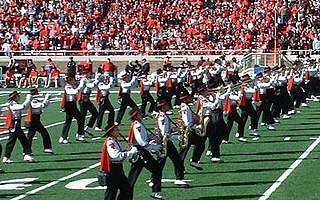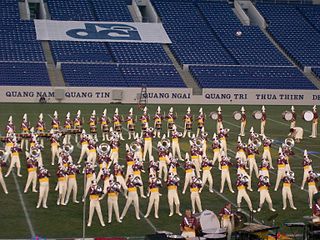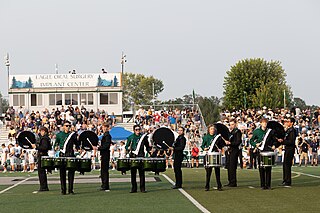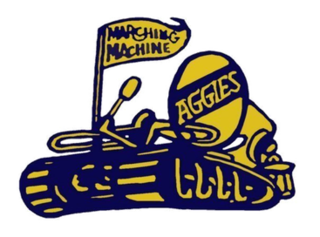
A marching band is a group of instrumental musicians who perform while marching, often for entertainment or competition. They are most popular in the United States, though not uncommon in other parts of the world. Instrumentation typically includes brass, woodwind, and percussion instruments. Most marching bands wear a uniform, often of a military style, that includes an associated organization's colors, name or symbol. Most high school marching bands, and some college marching bands, are accompanied by a color guard, a group of performers who add a visual interpretation to the music through the use of props, most often flags, rifles, and sabers.

A modern drum and bugle corps is a musical marching unit consisting of brass instruments, percussion instruments, electronic instruments, and color guard. Typically operating as independent non-profit organizations, corps perform in competitions, parades, festivals, and other civic functions. Participants of all ages are represented within the corps activity, but the majority are between the ages of 13 and 22 and are members of corps within Drum Corps International or Drum Corps Associates.

A pipe band is a musical ensemble consisting of pipers and drummers. The term pipes and drums, used by military pipe bands is also common.

Classic drum and bugle corps are musical ensembles that descended from military bugle and drum units returning from World War I and succeeding wars. Traditionally, drum and bugle corps served as signaling units as early as before the American Civil War, with these signaling units having descended in some fashion from ancient drum and fife corps. With the advent of the radio, bugle signaling units became obsolete and surplus equipment was sold to veteran organizations. These organizations formed drum and bugle corps of civilians and veterans, and the corps performed in community events and local celebrations. Over time, rivalries between corps emerged and the competitive drum and bugle corps circuit evolved.

Marching percussion instruments are percussion instruments specially designed to be played while moving. This is achieved by attaching the drum(s) to a special harness worn by the drummer, although not all marching bands use such harnesses and instead use traditional baldrics to sling their drums.
A tenor drum is a membranophone without a snare. There are several types of tenor drums.

The Blue Devils Drum and Bugle Corps is a World Class competitive junior drum and bugle corps based in Concord, California. The Blue Devils are members of Drum Corps International (DCI). They have finished first or second since 2007, and have placed no lower than fifth since 1975. They also hold the record for the highest score in DCI history, winning the 2014 DCI World Championships with a score of 99.65. The Blue Devils are the current DCI Champions, with a record of twenty-one titles to date.

A drum major or field commander is the leader of a marching band, drum and bugle corps, or pipe band, usually positioned at the head of the band or corps. The drum major is often dressed in more ornate clothing than the rest of the band or corps and is responsible for providing commands to the ensemble, leading them while marching, and directing them what to play, when to play, the dynamic or volume of playing, and what time to keep. The commands may be given verbally, through hand gestures, using a whistle or a baton, or with a mace. Although the drum major is the one conducting for the entire band to see and watch to keep time, the drum major is actually looking at the center snare's feet to keep time. The center snare is the leader of the drumline, and is the one who keeps the band in time while marching. They usually play, tap and/or rolls to set the tempo of how fast the band marches.

The University of New Hampshire Wildcat Marching Band, is the official marching band of the University of New Hampshire. The WMB plays at home games of the Wildcat football team, typically one away game per season, the Dover and Salem band shows, and various parades across New England. The band has traditionally had an equal mix of music and non-music majors and claims to have an average GPA consistently above the university's average. The WMB usually marches 80 to 100 members, depending on the year. Its largest roster in the past decade was approximately 125.

Color guards or Flag corps are teams of performers who perform choreographed dances and routines with various equipment to enhance and interpret the music of a marching band or drum and bugle corps show. Color guard teams can be found in American colleges, universities, high schools, middle schools, and independent drum corps. They use various equipment including flags, fake rifles, and sabres, along with other props. Most Color Guard groups are of mixed gender but some may also be single gender.

The Purdue "All-American" Marching Band is the marching band of Purdue University and performs at Purdue Boilermakers football games. The AAMB is also the official band of the Indianapolis 500 race, having held the position since 1919.

The Western Illinois University Marching Leathernecks is the marching band for Western Illinois University in Macomb, Illinois. The group was formed in 1904.

A corps of drums, sometimes known as a fife and drum corps or simply field music, is a traditional European military music formation. In contrast to a military band, a Corps of Drums' primary role is communication. Historically, music was used as signaling device for keeping the march tempo and delivering commands. Today, the primary role of a Corps of Drums is ceremonial, performing in parades and military ceremonies. Besides drums, this formation may contain a variety of instruments, including trumpets, bugles, and fifes.

A fanfare band, fanfare corps, fanfare battery, fanfare team, horn and drum corps, bugle band, drum and bugle corps, or trumpet and drum band is a military or civilian musical ensemble composed of percussion instruments, bugles, natural horns and natural trumpets. Fanfare bands are the descendants of the old medieval trumpet and drum teams that sounded fanfares on important occasions and are related to drum and bugle corps internationally.

A Corps style band is a type of marching band based on those of Drum Corps International. Notable differences include the introduction of the roll step, backwards marching and sliding, and the "8 to 5" step size.

Canadian military bands are a group of personnel in the Canadian Armed Forces (CAF) that performs musical duties for military functions. Military bands form a part of the Music Branch of the CAF, composed of six full-time professional Regular Force bands, 15 Regular Force voluntary bands, and 53 part-time reserve force bands. Bands of the Music Branch are often badged with the unit or Canadian Forces base insignia that they support.

The Blue and Gold Marching Machine is the official marching band of North Carolina A&T State University. The Blue and Gold Marching Machine performs pre-game and halftime shows at all North Carolina A&T Aggies football home games and travels to most away games.

The Military Band Service of the Armed Forces of the Russian Federation serves as the official service of military bands in active service within the Russian Armed Forces and formerly the Soviet Armed Forces. It is part of the Military Band Service Directorate of the General Staff of the Armed Forces of the Russian Federation.

A fanfare trumpet, also called a herald trumpet, is a brass instrument similar to but longer than a Regular trumpet, capable of playing specially composed fanfares. Its extra length can also accommodate a small ceremonial banner that can be mounted on it.

The Brazilian Marine Pipes, Drum and Bugle Corps is the only field music formation in service in the Brazilian Marine Corps and within the wider Brazilian Navy, and one of a few active formations today in service in the Brazilian Armed Forces. Formed in 1822 on the basis of the field music formations of the present day Portuguese Marine Corps stationed in Brazil, it is also the oldest in South America.


















